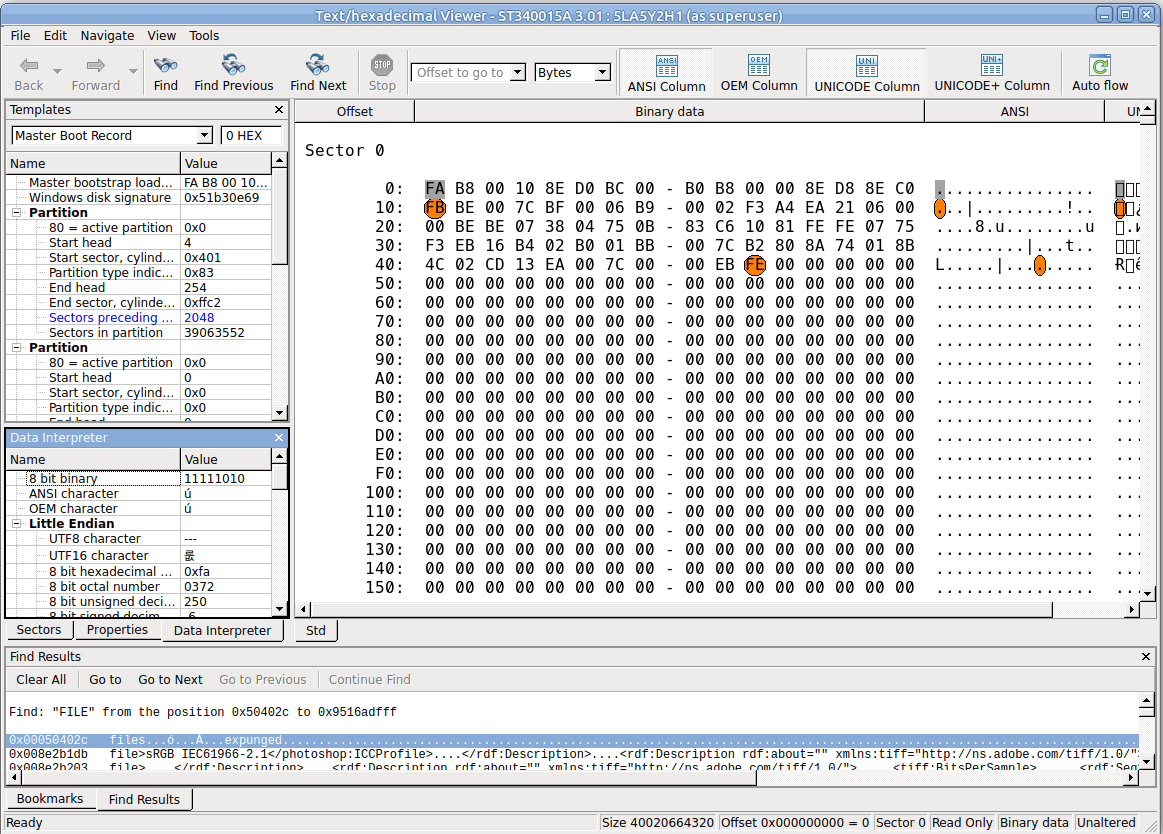- Contents
- Index
- Introduction to R-Linux
- Data Recovery Using R-Linux
- Text/Hexadecimal Viewer
- Technical Information and Troubleshooting
© 2025 R-Tools Technology Inc.
All rights reserved.
Viewing Objects
To view an object,
| 1 | Right-click the object and select View on the context menu |
 Other ways to view the object
Other ways to view the object
|
• Select the object and select View on the File menu or • Select the object and press the Ctrl+E keys |
| > | A Viewer panel will appear |
 R-Linux Text/Hexadecimal viewer
R-Linux Text/Hexadecimal viewer
|
Click the panel regions to learn their functions. |
Panel view options
You may set which panels and bars to enable/disable.
 To enable/disable:
To enable/disable:
|
ANSI data |
Select/clear ANSI on the View menu |
|
OEM data |
Select/clear OEMr on the View menu |
|
UNICODE data |
Select/clear UNICODE on the View menu |
|
UNICODE+ data |
Select/clear UNICODE+ on the View menu |
|
Toolbar |
Select/clear Toolbar on the View menu |
|
Properties View |
Select/clear Properties View on the View menu |
|
Sectors View |
Select/clear Sectors View on the View menu |
|
Data Interpreter View |
Select/clear Data Interpreter View on the View menu |
|
Template View |
Select/clear Template View on the View menu |
|
Bookmarks View |
Select/clear Bookmarks View on the View menu |
|
Find Results View |
Select/clear Find Results View on the View menu |
| 2 | View the information |
Viewing
You may view data in 4 various code pages: ANSI/OEM/UNICODE/UNICODE+ by switching on/off the respective code pages in the Code pages buttons or select the appropriate code pages on the View menu.
Patterns or Templates
You may select a pattern according to which the data will be parsed and shown in the parsed data pane. The Data Interpreter shows the data selected on the Template pane in various representations.
You may find the next or previous data that matches the pattern signature on the disk. Right-click the right pane of the viewer and select either Find Template Signature Next or Find Template Signature Previous on the context menu. You may also select these items on the Edit menu.
Navigating .
Text/hexadecimal viewer gives you various ways to navigate into an object. See the Navigating through an Object for more details.
Data Copy
Text/hexadecimal viewer gives you various ways to copy selected data navigate in an object. See the Data Copy for more details.
Selecting and saving an area in the Viewer
You may select an area in the Viewer panel and save it as a file.
To select and save an area in the Viewer panel ,
| 1 | Right-click the beginning of the selection and select Select From on the context menu |
| 2 | Right-click the end of the selection and select Select To on the context menu |
 Other ways to select an area
Other ways to select an area
|
• Select Select... on the Tools menu and specify an area to select on the Select dialog box, or • Click the start point of the area and drag the mouse cursor to its end. |
If you need to select an entire object, select Select All on the Tools menu or click the Ctrl+A key
| 3 | Select an appropriate item in the Tools menu to save the data in a required format and specify its file name |
Select:
|
Save to Binary File... |
to save the data in the binary format (default extension is .bin ) |
|
Save to Hexadecimal File |
to save the data in the binary format (default extension is .hex ) |
on the Tools menu.
If you select an existing file, R-Linux will ask you if you want to append or overwrite the file.
| > | Viewer will save the data to the file |
- R-Studio Technician: activation using a USB stick
- Data Recovery Guide
- Why R-Studio?
- R-Studio for Forensic and Data Recovery Business
- R-STUDIO Review on TopTenReviews
- File Recovery Specifics for SSD devices
- How to recover data from NVMe devices
- Predicting Success of Common Data Recovery Cases
- Recovery of Overwritten Data
- Emergency File Recovery Using R-Studio Emergency
- RAID Recovery Presentation
- R-Studio: Data recovery from a non-functional computer
- File Recovery from a Computer that Won't Boot
- Clone Disks Before File Recovery
- HD Video Recovery from SD cards
- File Recovery from an Unbootable Mac Computer
- The best way to recover files from a Mac system disk
- Data Recovery from an Encrypted Linux Disk after a System Crash
- Data Recovery from Apple Disk Images (.DMG files)
- File Recovery after Re-installing Windows
- R-Studio: Data Recovery over Network
- How To Use R-Studio Corporate Package
- Data Recovery from a Re-Formatted NTFS Disk
- Data Recovery from an ReFS disk
- Data Recovery from a Re-Formatted exFAT/FAT Disk
- Data Recovery from an Erased HFS Disk
- Data Recovery from an Erased APFS Disk
- Data Recovery from a Re-Formatted Ext2/3/4FS Disk
- Data Recovery from an XFS Disk
- Data Recovery from a Simple NAS
- How to connect virtual RAID and LVM/LDM volumes to the operating system
- Specifics of File Recovery After a Quick Format
- Data Recovery After Partition Manager Crash
- File Recovery vs. File Repair
- Data Recovery from Virtual Machines
- How to Connect Disks to a Computer
- Emergency Data Recovery over Network
- Data Recovery over the Internet
- Creating a Custom Known File Type for R-Studio
- Finding RAID parameters
- Recovering Partitions on a Damaged Disk
- NAT and Firewall Traversal for Remote Data Recovery
- Data Recovery from an External Disk with a Damaged File System
- File Recovery Basics
- Default Parameters of Software Stripe Sets (RAID 0) in Mac OS X
- Data Recovery from Virtual Hard Disk (VHD/VHDX) Files
- Data Recovery from Various File Container Formats and Encrypted Disks
- Automatic RAID Parameter Detection
- IntelligentScan Data Recovery Technology
- Multi-pass imaging in R-Studio
- Runtime Imaging in R-Studio
- Linear Imaging vs Runtime Imaging vs Multi-Pass Imaging
- USB Stabilizer Tech for unstable USB devices
- Joint work of R-Studio and PC-3000 UDMA hardware
- Joint work of R-Studio and HDDSuperClone
- R-Studio T80+ - A Professional Data Recovery and Forensic Solution for Small Business and Individuals Just for 1 USD/day
- Backup Articles
- R-Drive Image Standalone and Corporate license transferring
- Fixing Windows update error 0x80070643 with R-Drive Image
- Backup with Confidence
- R-Drive Image as a free powerful partition manager
- Computer Recovery and System Restore
- Disk Cloning and Mass System Deployment
- Accessing Individual Files or Folders on a Backed Up Disk Image
- R-Drive Image startup / bootable version
- File Backup for Personal Computers and Laptops of Home and Self-Employed Users
- Creating a Data Consistent, Space Efficient Data Backup Plan for a Small Business Server
- How to Move the Already Installed Windows from an Old HDD to a New SSD Device and Create a Hybrid Data Storage System
- How to Move an Installed Windows to a Larger Disk
- How to Move a BitLocker-Encrypted System Disk to a New Storage Device
- How to backup and restore disks on Linux and Mac computers using R-Drive Image
- Undelete Articles
- Get Deleted Files Back
- Free Recovery from SD and Memory cards
- R-Undelete: Video Recovery
- Recovery from an External Device with a Damaged File System
- File recovery from a non-functional computer
- Free File Recovery from an Android Phone Memory Card
- Free Photo and Video File Recovery Tutorial
- Easy file recovery in three steps



